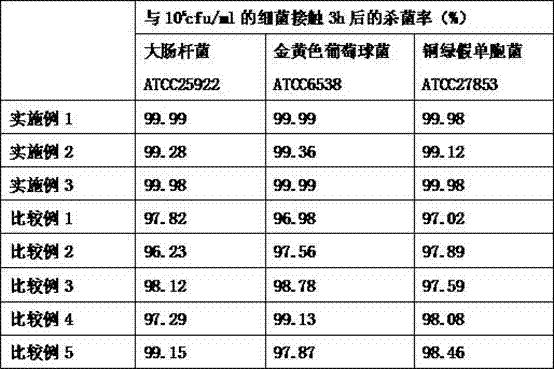Tableware detergent with anti-bacterial function
A tableware detergent and antibacterial effect technology, applied in the field of daily chemicals, can solve problems such as skin irritation, detergent reduces transparency, limited bacteria, etc., achieves the removal of dirt and pesticide residues, strong cleaning and decontamination effects, and strong bactericidal effects Effect
- Summary
- Abstract
- Description
- Claims
- Application Information
AI Technical Summary
Problems solved by technology
Method used
Image
Examples
Embodiment 1
[0024] A dishwashing agent with antibacterial effect is made of the following raw materials in parts by weight: 5 parts of sucrose palmitate, 6 parts of alkyl glycosides, 8 parts of dodecyl dimethyl betaine, 5 parts of chitosan, 4 parts of secondary alkyl sodium sulfonate, 1 part of sodium alginate, 1.5 parts of sodium sulfate, 2.5 parts of sodium perborate, 1 part of sodium citrate, 2 parts of sodium chloride, 3 parts of sodium hydroxypropyl methylcellulose, yellow 4 parts of raw gum, 3 parts of lipase, 0.6 part of tea saponin, 0.8 part of bactericide, 1.0 part of chelating agent, 0.3 part of essence, 6 parts of glycerin, 8 parts of ethanol, 30 parts of deionized water; Blend of Fall Back Extract, Aloe Vera Extract, Arborvitae Leaf Extract, and Cinnamon Extract.
[0025] The preparation method comprises the following steps:
[0026] (1) Prepare materials according to the dosage of each component;
[0027] (2) Add deionized water to the configuration tank, and heat it, contr...
Embodiment 2
[0032] A dishwashing agent with antibacterial effect is made of the following raw materials in parts by weight: 9 parts of sucrose palmitate, 6 parts of alkyl glucoside, 6 parts of dodecyl dimethyl betaine, 8 parts of chitosan, 2 parts of sodium secondary alkyl sulfonate, 0.5 parts of sodium alginate, 2 parts of sodium sulfate, 2.5 parts of sodium perborate, 1.0 parts of sodium citrate, 2.5 parts of sodium chloride, 2 parts of sodium hydroxypropyl methylcellulose, yellow 4 parts of raw gum, 2 parts of lipase, 0.8 part of tea saponin, 1.5 parts of bactericide, 0.6 part of chelating agent, 0.4 part of essence, 6 parts of glycerin, 5 parts of ethanol, 40 parts of deionized water; The bactericide is guanidine fungicides;
[0033] The preparation method comprises the following steps:
[0034] (1) Prepare materials according to the dosage of each component;
[0035] (2) Add deionized water to the configuration tank, and heat it, control the temperature to 60°C, then add sucrose pa...
Embodiment 3
[0040] A dishwashing agent with antibacterial effect is made of the following raw materials in parts by weight: 6 parts of sucrose palmitate, 9 parts of alkyl glycosides, 8 parts of dodecyl dimethyl betaine, 5 parts of chitosan, 2 parts of sodium secondary alkyl sulfonate, 1.5 parts of sodium alginate, 1 part of sodium sulfate, 1 part of sodium perborate, 2 parts of sodium citrate, 2 parts of sodium chloride, 3 parts of sodium hydroxypropyl methylcellulose, yellow 2 parts of raw gum, 3 parts of lipase, 0.8 part of tea saponin, 1.2 parts of bactericide, 1.8 parts of chelating agent, 0.3 part of essence, 8 parts of glycerin, 6 parts of ethanol, 35 parts of deionized water; Blend of Fall Back Extract, Aloe Vera Extract, Arborvitae Leaf Extract, and Cinnamon Extract.
[0041] The preparation method comprises the following steps:
[0042] (1) Prepare materials according to the dosage of each component;
[0043](2) Add deionized water to the configuration tank, and heat it, contro...
PUM
 Login to View More
Login to View More Abstract
Description
Claims
Application Information
 Login to View More
Login to View More - R&D
- Intellectual Property
- Life Sciences
- Materials
- Tech Scout
- Unparalleled Data Quality
- Higher Quality Content
- 60% Fewer Hallucinations
Browse by: Latest US Patents, China's latest patents, Technical Efficacy Thesaurus, Application Domain, Technology Topic, Popular Technical Reports.
© 2025 PatSnap. All rights reserved.Legal|Privacy policy|Modern Slavery Act Transparency Statement|Sitemap|About US| Contact US: help@patsnap.com

